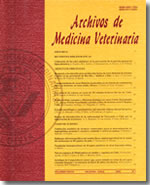Antigenic comparison and immune response in challenges mice with virus CVS and "street" and "fixed" isolates presumably atipics of rabies virus
Main Article Content
Abstract
Rabies is a disease caused by neurotropic virus which has the capability to infect a wide range of animals and humans.
Antigenic analysis of a wide variety of fixed (vaccine strains) and street viruses with monoclonal antibodies has revealed considerable antigenic variation among the samples of viruses isolated from different host species, or geographical locations. These marked antigenic variations have potentially serious implications for rabies control strategies.
We studied the patterns of "street" and "fixed" rabies virus isolates compared with the prototype Challenge Virus Standard (CVS), using the Fuenzalida-Palacios rabies vaccine and anti-rabies serum standard. Six street rabies virus were used. These were detected and isolated in 1985, at the Public Health Institute of Chile.
First, suckling mice were inoculated with street rabies virus 85/423, 85/433, 85/684, 85/882, 85/1068, 85/1091. The detection of rabies virus antigen in CNS tissues was performed with the direct immunofluorescence technique. These positive samples were used for the viral passage in mice. Next, brain tissues from mice experimentally infected with street virus were used for the next intracerebral inoculation. This street rabies virus was fixed.
We analysed role of Fuenzalidad-Palacios vaccine in induction of protective immune response against a lethal infection in suckling mice with six street rabies virus ( 85/423, 85/433, 85/684, 85/882, 85/1068 and 85/1091), challenge virus standard (CVS) and fixed rabies virus (85/423, 85/433, 85/684, 85/882, 85/1068 and 85/1091).
To study the protection of anti-rabies serum, mice were inoculated intracerebrally with preincubated mixtures of anti-rabies serum with virus CVS and anti-rabies serum with fixed rabies virus.
The results indicated that the Fuenzalida-Palacios vaccine, experimentally produced only partial protection against a lethal intracerebral challenge with rabies virus. We demostrate that, administration of anti-rabies serum resulted in insufficient protection.
Therefore, these results are suggestive to us that exist an heterogenecity in street rabies virus.

